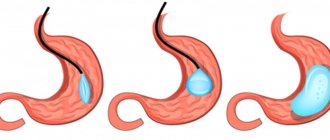Anorexia: causes, symptoms, treatment, prevention
Description of the problem - characteristics of anorexia nervosa, how to identify the disease, diagnostic methods. Treatment of neuropsychiatric disorders, rehabilitation and prevention.
Nutrition is the basis for maintaining health and the harmonious functioning of all processes in the body. Every year the media penetrate more deeply into the everyday life of citizens and form new trends. At the end of the 20th century, it became fashionable to be thin, and new beauty standards emerged. For most people, meeting the requirements of society is a rule that provides freedom, erasing boundaries and boundaries. The desire of both women and men to lose weight in order to follow the canons of attractiveness has become justified, but this new trend also has an extreme - anorexia nervosa.
Causes of anorexia nervosa in children
The cause of childhood anorexia nervosa is considered to be adolescent dissatisfaction with their body.
Due to the constant influence of the media, the cultivation of certain ideals of beauty, and the demonstration of the success of individual representatives of show business, stereotypes are formed among teenagers. They evaluate themselves and try to be like their idols. As a result of such comparisons, dissatisfaction with one's own body arises. One of the options for solving the problem in the eyes of a teenager is the deliberate refusal of proper nutrition. Psychologists and psychiatrists have found in research that most patients with anorexia nervosa are hypersocial. This means that it is very important for them:
- to be the center of attention;
- receive positive feedback about your activities and appearance;
- achieve success in daily endeavors.
60-65% of teenagers suffering from this disease are class leaders, clubs or other meetings.
Many patients have an “excellent student complex.” Therefore, if they do not meet the criteria of their ideal, such teenagers are prone to radical measures to achieve their goal. One of them is to give up food to achieve noticeable weight loss. Psychologists also point out possible problems in the family when parents are too demanding of the child and constantly set other children or even adults as examples.
Characteristics of anorexia
Anorexia nervosa is considered a mental disorder. When gaining weight, a person unconsciously refuses to accept his own body. First, there is dissatisfaction with one’s appearance, reflection in the mirror. The patient tries to correct the situation by losing weight, but chooses the wrong path - refusing to eat, strict diets, physical activity without reasonable restrictions, using appetite suppressants, diuretics, laxatives, and also resorting to inducing vomiting after eating. So the patient achieves the desired result, but it no longer satisfies him. With the correct proportions, a person considers himself obese and continues weight loss measures. Due to improper eating behavior, all organs and systems of the body suffer. First of all, the functioning of the nervous system, gastrointestinal tract, urine and genital area is disrupted, and immunity is reduced.
The patient looks exhausted, excessive thinness is perceived by him as beauty, but disturbances in the functioning of the body overshadow life.
Anorexia
Vomit
2338 01 September
IMPORTANT!
The information in this section cannot be used for self-diagnosis and self-treatment.
In case of pain or other exacerbation of the disease, diagnostic tests should be prescribed only by the attending physician. To make a diagnosis and properly prescribe treatment, you should contact your doctor. Anorexia: causes, symptoms, diagnosis and treatment methods.
Definition
Anorexia, or anorexia nervosa (Twiggy syndrome), is a serious mental eating disorder characterized by a compulsive desire to lose weight, fear of obesity, and a distorted body image. Its mortality rate in some countries reaches 18%.
Anorexia primarily affects women, and, as a rule, young women - 95% of patients are 12-30 years old.
There is evidence that in economically developed countries in recent years the percentage of patients with anorexia among young men has been growing. The disease is often accompanied by other mental disorders.
Causes of anorexia
Anorexia can be caused by many factors.
- Family.
There is evidence that in approximately 42% of cases in patients diagnosed with anorexia, family relationships were characterized by a high level of conflict or one of the parents suffered from alcoholism. Eating disorders in relatives increase the likelihood of a child becoming ill, as does their tendency to be overweight. - Biological.
In people with obesity and early menarche, anorexia is more often detected due to hormonal dysfunction (excessive production of leptin and dysfunction of the neurotransmitters serotonin, dopamine, norepinephrine). - Cultural. The modern fashion for thinness, which since childhood has caused increased concern about one’s weight and appearance, leads to women and girls resorting to strict diets.
- Stressful.
The trigger for the development of anorexia can be any stressful situation (death of a loved one, divorce, sexual violence, etc.). - Social.
Difficulties in social adaptation, ridicule at school or bad relationship experiences can be a trigger for the development of anorexia. Modern social networks provide an opportunity for girls who are interested in unhealthy weight loss to unite in groups and feel supported. - Genetic.
Research is currently underway into the connection between genetic predisposition to anorexia and other emotional disorders.
Classification of the disease
There are two types of anorexia nervosa:
- Restrictive type
- characterized by a sharp restriction in food, episodes of overeating, which do not end with artificially induced vomiting. Patients often exhaust themselves with excessive physical exertion. - Purging type
- patients with this type of anorexia constantly overeat and induce vomiting, take laxatives, diuretics, and perform enemas.
according to severity
based on body mass index (BMI):
- mild - BMI is 17-17.99;
- moderate - BMI is 16-16.99;
- severe - BMI is 15-15.99;
- extreme - BMI less than 15.
Symptoms of anorexia
The disease is divided into periods, each of which is characterized by certain symptoms:
Dysmorphomaniac
– this period is characterized by the predominance of thoughts about one’s own imperfection over actions. A person is depressed, feels anxious, and may look at himself in the mirror for a long time. The first food restrictions begin with the help of diets.
Anorexic period
defined as persistent starvation when the loss of body weight is 20-50% of the initial weight. Patients feel the joy of the weight loss effect and tighten their diet even more.
Significant loss of body weight is accompanied by dizziness, weakness, decreased heart rate, and decreased blood pressure.
Due to systematically induced vomiting, dehydration occurs. At this stage, secondary diseases of the gastrointestinal tract appear - gastroenterocolitis, gastroenteroptosis, so refusal to eat is now associated not only with the fear of gaining weight, but also with the fear of painful sensations in the abdomen. In addition, dry skin appears, hair loss increases, the menstrual cycle in women and spermatogenesis in men are disrupted, and libido decreases.
Cachexic period
characterized by irreversible degeneration of internal organs, and the loss of body weight is already more than 50% of the initial weight. The changes that occur can lead to death, although patients still believe that they are overweight and refuse to eat, which is regarded as a delusional disorder.
Reduction of anorexia nervosa
. If the disease is diagnosed on time and correct treatment is carried out, then the mental and somatic state gradually normalizes and the patient recovers.
Diagnosis of anorexia
Diagnosis of anorexia nervosa primarily involves a thorough history taking. The doctor finds out the duration of changes in eating behavior, the presence of allergies, a detailed diet, the dynamics of height, weight, body mass index, whether induction of vomiting was practiced, the use of enemas, the use of medications for weight loss, the presence of increased physical activity, the frequency of episodes of bulimia, evaluates the characteristics of menstrual cycle.
A thorough examination of the patient is carried out to determine the general condition of the body and identify concomitant pathologies.
- Blood test to detect anemia.
Symptoms of anorexia
In medical practice, a classification of signs has been developed by which it is easy to recognize the onset of the disease and its course. They allow you to understand how far anorexia has gone, how to prevent the consequences and complications of the disease.
The main features include:
- dissatisfaction with external data, constant feeling of fullness, excess weight, non-acceptance of proportions;
- the patient denies the presence of problems and refuses treatment;
- limits himself to food, reduces portions, refuses foods;
- sleeps poorly, insomnia appears;
- depression, touchiness, apathy, irritability, aggression in communication with others are observed;
- afraid of gaining weight, exceeding the weight limit;
- plays sports intensively, increasing physical activity each time;
- refuses to attend events where food will be eaten;
- visits the toilet frequently;
- induces vomiting to remove food from the stomach;
- excessively addicted to diets;
- due to exhaustion, performance decreases, attention and concentration on usual activities are impaired.
Signs of anorexia appear at different stages of the disease. A person in need of therapeutic intervention will not consult a doctor on his own; he himself will not be able to begin treatment for anorexia, due to lack of awareness of problematic issues. It is important that relatives and close people notice negative changes and convince the patient to visit a specialist at an early stage.
Symptoms of anorexia nervosa vary depending on gender. According to statistics, women are more often affected by the disorder, but in practice it is also diagnosed in men.
Signals of anorexia in girls:
- the skin becomes dry, the face becomes sallow;
- hair and nails look painful;
- frequent migraines;
- dystrophy of internal organs develops;
- absence of menstruation or its irregularity, pain;
- inability to become pregnant and give birth;
- exhaustion.
In most cases, the pathology develops in girls during adolescence, when hormonal characteristics appear, emotional outbursts are visible, frequent mood swings, and the psyche is unstable.
Young people are not as likely to be at risk, but are also susceptible to the syndrome. They are characterized by:
- hair loss on the head;
- chronic fatigue and irritability;
- desire for a strong increase in physical activity;
- tendency to drink alcohol;
- decreased sexual desire and potency.
As anorexia nervosa progresses, the number of symptoms increases. If a visit to the clinic does not take place in a timely manner, or medical and psychological assistance is not provided, the changes become irreversible, which leads to death.
Signs of developing anorexia
- constant preoccupation with one's weight and appearance;
- reluctance to eat at a common table;
- constant dissatisfaction with the achieved result, although the weight loss was greater than planned;
- distorted perception of one’s appearance: even with severe emaciation, the teenager sees himself as fat;
- non-recognition of illness;
- depression;
- fatigue, irritability;
- cessation of menstruation in girls;
- alternating periods of aversion to food with bouts of bulimia;
- calorie counting, constant weighing;
- mirror symptom: constantly looking for figure flaws in front of the mirror.
In the case of bulimia, a person first experiences extreme hunger and cannot stop eating, and then experiences feelings of guilt and self-loathing, causing vomiting.
The disease begins to develop in adolescence because rapid changes occur in the body, hormonal changes, which indicate the need to soon enter adulthood:
- accept your sexuality
- adapt to new relationships and demands of society.
Such a morbid interest of a girl or boy in his body means that mentally he (she) is not ready for these life tasks. The inability to adequately adapt to reality shifts to dissatisfaction with one's body . The teenager says to himself and everyone around him: if only I were thin and looked normal, then everything would be fine with me. And if you don’t notice this problem in time, you can waste precious time. Because while a teenager is focused on his appearance, he loses his position in other areas: he abandons his studies, narrows his social circle, etc.
In addition, an unbalanced and extremely poor diet after some time begins to affect the nervous and hormonal systems, which aggravates the condition of increased fatigue, anxiety and depression.
Why does anorexia develop?
The causes of anorexia go deep into individual personality traits. Nervous pathology is detected in people who are insecure and have low self-esteem. Each case is considered by a psychiatrist on an individual basis, because each patient has a unique life history and a burden of problems dating back to childhood.
Anorexia is caused by:
- Unfavorable genetic factors - in the pedigree, the ancestors suffered from exhaustion, which was passed on to their descendants. Its activation occurs under severe stress, unsuccessful weight loss, or incorrect daily schedule.
- Obesity in childhood - being overweight for a long time provokes a desire to return to normal, but with negative experiences there is a possibility of developing anorexia.
- The onset of the first menstruation earlier than physiologically planned. Subsequently, difficulties are discovered in the release of the hormones serotonin, norepinephrine, and dopamine, which are responsible for eating behavior.
- Personal aspects - dislike for oneself, non-acceptance of the body, weight, imbalance in emotions are formed under the influence of traumatic life circumstances. For example, lack of support from mother and father when a minor is trying to find his own style and image. Students often experience depression due to bullying from peers due to excess weight, as a result of which there is a strong desire to lose weight without noticing global changes.
- Fashion for thinness, broadcasting trends in the media.
Identifying cause-and-effect relationships is a step towards proper treatment. The situation is complicated by the fact that not only the employee of the healthcare institution, but also the patient must be aware of the seriousness. If this condition is not met, measures to restore lost functions will remain ineffective.
Types of anorexia
In medicine, there are several types of disorder. They differ in the reasons that provoked the appearance of anorexia.
Types of anorexia include:
- nervous (self-limitation is realized consciously, fear of gaining weight, which is considered unnecessary for the anatomy, there is no correct perception of appearance);
- medicinal (with excessive use of psychostimulants and antidepressants);
- mental (the feeling of hunger is lost due to disruptions in brain dynamics, accompanied by depression, schizophrenia, paranoia);
- symptomatic (the main reason does not lie in mental disorders, the woman suffers from somatic ailments in gynecology, lung function, hormones, intestines).
The type of treatment used depends on the type of anorexia. Anorexia nervosa and mental anorexia are similar, but have fundamental differences in characteristics. The primary task is to separate them, because if there are diagnoses of schizophrenia and paranoia, serious treatment is necessary, including hospitalization.
Stages of anorexia
The degrees of anorexia involve several stages of development, from its beginning to its end, if treatment is not implemented:
- At the first stage, discomfort is felt from the appearance, a feeling of fullness and excess weight arises. In the subconscious, the usual aspects of eating behavior are being transformed into new ones aimed at losing weight. Even if there are actually no extra pounds, their presence is felt. The words of close relatives about the need to change something in themselves are perceived as an insult and are not taken into account.
- At the second stage - anorectic, the individual takes real steps to lose weight, leading to the loss of half of the existing volume. Organs are damaged, which provokes serious concomitant diseases. Outwardly, he becomes exhausted, due to a lack of vitamins, minerals, and beneficial microelements, hair falls out, nails peel, teeth crumble, but his intellect remains. With the inflammatory process of the gastrointestinal tract, dark circles appear under the eyes and the skin becomes dry.
- The cachectic degree is characterized by cardinal changes in the gastrointestinal tract and central nervous system, stopping the hormonal process. Exhaustion turns into dystrophy, muscles and heart quickly wear out, blood circulation is impaired, which affects the color of the skin (it turns blue). Subconsciously changed attitudes do not allow the sufferer to see the problem and seek help, tries to isolate himself from society, and reduces physical activity. If treatment is not started, there is a risk of death.
- The reduction stage begins when a referral for hospital stay is issued. Under the supervision of a nutritionist, kilograms are gained, but psychological problems remain, so there is a desire to lose weight again. These relapses also occur after rehabilitation, so constant support from a psychotherapist is indicated during 2 years of recovery.
Relatives and friends of the addict are advised to stay nearby to prevent relapse. After all, at any moment he risks succumbing to the influence of the disorder and taking the path of meaningless weight loss for himself.
Consequences of anorexia
With anorexia, appearance is perceived in a distorted form, there is a fear of gaining weight, so fasting is chosen as the only way. Due to the lack of vitamins and beneficial microelements, all processes slow down, there is not enough energy not only for physical activity, but also to maintain vital functions.
Prolonged stay in an exhausted state entails consequences:
- problems with memory, thinking;
- depressed mood, emotional incontinence;
- apathy, muscle weakness, inability to do usual activities due to lack of strength;
- soreness of the structure of the skin, nails and hair;
- gas formation, difficulty in defecation;
- disruptions in the cardiovascular system, instability of blood pressure;
- slow tooth decay, bleeding gums;
- dizziness, tendency to faint;
- osteoporosis;
- infertility.
These signals for help symbolize that treatment and psychological support are required. If you do not receive them, then the only outcome of the pathology is death. In practice, there are stories when people understood the inevitability of serious difficulties, did not cope, and ended their lives by suicide, which is the final result of deviations.
Diagnosis of anorexia
To identify anorexia, a visit to a psychiatrist who specializes in the treatment of eating disorders is required. Diagnosis begins with collecting anamnesis. Through a survey, he finds out general information about the patient - age, marital status, social status, environment, worldview, genetic predisposition, risk factors, bad habits, concomitant and chronic diseases. Any information that provoked anorexia is important.
At the initial stage of treatment, it is necessary to understand whether there are deviations in eating behavior. Evaluated according to the following criteria:
- how a person relates to certain categories of products, whether he avoids consuming them, and in what quantities he prefers to eat;
- are certain stereotypes detected during breakfast, lunch, dinner;
- how much time does it take for breakfast, lunch and dinner, is the regime followed;
- amount of fluid consumed (insufficient, excessive);
- whether any foods are excluded from the diet.
If an analysis of the answers to these questions shows deviations from the norm, we can talk about the presence of pathology, but it is not always anorexia. To detect an anomaly, it is advisable to conduct additional research on other indicators:
- whether a critical and sharp weight loss is recorded (weight loss also occurs due to other circumstances - viral diseases, the influence of stress), therefore it is necessary to identify the basis for the occurrence of this bodily signal;
- attitude towards the figure, setting additional requirements for proportions;
- the use of physical activity, whether it leads to dystrophy;
- lack of menstruation in girls, hormonal instability.
Having considered all the information, parameter criteria indicating a proportional deficit, psychological characteristics indicating non-acceptance of oneself, inadequate perception of the image in the mirror, a conclusion is made that anorexia has been identified.
During diagnostic measures, it is worth excluding the influence of other somatic ailments that lead to severe weight loss. The examination is carried out using magnetic resonance therapy to determine whether tumors are present. Their influence indicates symptoms similar to bulimia. A blood test allows you to see the development of infections, viruses, and hormonal imbalances. Calculation of body mass index reveals the idea of being normal according to weight standards.
Treatment of anorexia
Treatment includes a set of measures aimed at eliminating unfavorable circumstances and eliminating physiological pathologies. Anorexia is treated in a combination of several ways - psychotherapeutic, medication, and the organization of a proper diet. It is important for the sick person to understand the seriousness of the problem. The doctor often faces difficulties in motivating the patient to restore lost vital functions, because the patient believes that he is striving for the ideal and does not see problems. In most cases, people with disabilities receive treatment on an outpatient basis, while at home. Referral to a hospital is issued in case of an immediate threat to life, at an advanced stage of development of anorexia. For anorexia, you cannot use only one treatment method, then it is difficult to achieve a positive effect.
Anorexia nervosa in adolescents, features, causes of development
Among those suffering from the disease, 90-95% are teenagers and children. The main age range of patients is 12-15 years. Without timely treatment, 20% of cases of the disease lead to death, half of which are suicide.
Often the onset of painful changes occurs in the preschool stage. In the elementary grades they increase, and by puberty they reach their apogee. It is at this time that obvious, visible symptoms appear.
Factors underlying the formation of pathology:
- Hereditary predisposition. Bulimia, psychogenic anorexia, endogenous psychoses, and schizophrenia in relatives significantly increase the chance of morbidity.
- Physiological. The disease is predisposed by early puberty syndrome and hormonal imbalances, especially in teenage girls.
- Intrafamily. Strict educational measures, the individual characteristics of a child who cannot tolerate psychological and physical pressure, and a tendency to affect can serve as a trigger for violation of instincts.
- Personality characteristics. We are talking about children prone to feelings of inferiority, constant anxiety and self-doubt, and an obsessive desire to look better.
- Stereotypes of the surrounding world. In childhood, almost all boys and girls want to look according to imposed standards of beauty. One of them is thinness. Striving for the ideal, boys and girls go beyond the reasonable limit and “slide” into a painful state.
The main pathogenetic syndrome characteristic of this disease is dysmorphophobia. Its manifestations are obsessive thoughts about developing physical deformity due to obesity, which in fact does not exist. Delusional thoughts of adolescents are transformed into emotional disruptions and painful behaviors. An overvalued idea suppresses the normal instinct of self-preservation.
In response to this, the body “turns on” protective factors:
- Reduces metabolic rate.
- Reduces the content of insulin and enzymes.
- Reduces the desire to eat.
Against this background, symptoms of anorexia in adolescents appear.
Drug therapy for anorexia
The use of medications is a mandatory technology in the treatment of anorexia, but is not the main one. A dangerous circumstance is exhaustion and dystrophy, causing somatic ailments.
Given the damage to the immune system, the body cannot cope with the exacerbations that arise. Vulnerable places during the development of an anomaly are the stomach and intestines. Their vital activity is completely ruined due to the lack of protein, fat, and carbohydrates, which are building materials for muscles, rich in vitamins and minerals for strengthening bones. As a result of atrophy, disruptions in the functioning of the heart are recorded, blood pressure decreases, and the pulse weakens.
The central nervous system and brain function receive no less load; hunger prevents them from working fully, which affects the individual’s behavior. Constant fasting provokes the production of the hormone cortisol - the stress hormone.
Due to a lack of proteins, fats and carbohydrates, energy is lost, then the body begins to consume its own reserves. The breakdown of these trace elements forms ammonia and acetone, which create intoxication.
There are several groups of drugs used in the treatment of anorexia:
- Neuroleptics are psychotropic drugs that suppress excessive emotionality, psychosis, eliminate delusions, hallucinations, but maintain consciousness. They inhibit the central nervous system so that pathological excitability is not felt, and relieve muscle spasms (Aminazin, Tizercin, Leponex).
- Antidepressants - used for depressive syndrome, improve mood, block anxiety, irritability, restlessness, level out mental activity, promote rapid sleep (Novo - Passit, Persen, Deprim).
- Pharmacological agents that increase appetite are designed to stabilize the secretion of the gastrointestinal tract, stimulate the central nervous system, have a general strengthening effect, and eliminate intoxication (Elkar, Apilak, Bioaron S).
- Sedative medications - help cope with aggression, obsessive thoughts, stop panic attacks (Motherwort, Valerian, Nervoflux).
- Vitamins - the complex includes groups: A, B, C, D, E, P, K, iron. They participate in metabolism, eliminate tissue and cell degeneration, cope with illness, and increase resistance to infections and viruses (Complivit, Centrum, Carnitine).
| Name of medicine | Mode of application | Contraindications | Side effects |
| Frenolon |
|
|
|
| Elenium |
|
|
|
The treatment regimen is selected based on the patient’s symptoms and the stage of anorexia. A properly selected set of drugs helps to quickly restore the functioning of the body. In case of serious damage to internal organs, additional therapy is prescribed that specifically affects physiological indicators.
Psychotherapy for anorexia
Anorexia is classified as a mental disorder, so psychotherapy is considered the main method of treatment. The patient needs to destroy his established stereotypes in his views on the surrounding reality, increase self-esteem, and eliminate the feeling of inferiority. The goal of treatment is to learn to talk about difficulties and conflicts, to work through fears rooted in the subconscious.
In conversations with a specialist, you need to figure out what personal protests exist, whether there are destructive life attitudes and parental programs from childhood, consider the family history and biography of the person seeking help. The fight against the problem does not focus on correcting the mistakes of the past, but on their awareness and acceptance, overcoming interpersonal obstacles, and developing ways out.
Psychotherapeutic methods of influencing a person diagnosed with anorexia:
- Cognitive - behavioral - correction of a conditioned reflex formed incorrectly. The identified anomalies show that people suffering from anorexia did not take into account the rule - food intake is carried out when a feeling of hunger is felt. Their daily routine looked irregular, which amounted to almost unnecessary consumption of nutrients. The goal of treatment is to form an adequate image of one’s appearance, accept it as it is, and destroy the ideal of thinness. During classes in the form of conversations, the client thinks about the need for imposed attitudes and their impact.
- Family psychotherapy - the close environment plays an important role; in the initial stages of anorexia, its manifestations are not always noticeable. The family provides support, but relatives who have not previously encountered such difficulties may unwittingly aggravate the situation. This happens when strict demands are placed on an anorexic person to eat food in order to gain weight, because any actions forcefully provoke a protest reaction, the patient withdraws and begins to hide his problems. A mediator in conflicts between family members, who knows the boundaries of communication, will teach relatives the skills of compromise.
- Body-oriented therapy - defects in psychological characteristics are manifested in the reaction of the body. Failure to accept the appearance in the mirror is the result of a defensive reaction of the psyche. Restrictions or refusal of nutrients are regarded as a manifestation of aggression towards oneself due to a lack of love and warmth from loved ones. Inside, he feels abandoned and lonely, which provokes suicidal thoughts or attempts to leave life. Vomiting with bulimia looks like liberation from principles dictated by someone; the psyche is no longer able to keep them within itself. The patient enters into the position of a victim so that those who are indifferent will pay attention, shifting responsibility for their life and health onto them.
The efforts of a team of specialists provide a positive effect, an opportunity to look at problems from a different perspective, work through phobias with a high degree of effectiveness, eliminate interpersonal problems, and develop a strategy to overcome a difficult life situation by replacing negative ideals with positive images.
Tyulyachinskaya central district hospital
Home Articles Anorexia in adolescents. How dangerous is she?
At a young age you always want to be beautiful. But the desire to meet modern beauty standards can lead to serious health problems. This problem is especially relevant for adolescents whose psyche is developing. And from television, glossy magazines, and the film industry there is enormous pressure: a beautiful girl is a very thin girl. This becomes one of the reasons for the development of anorexia in adolescence.
I don't want to eat
Most recently, Olympic figure skating champion Yulia Lipnitskaya retired from the sport. In 2014 in Sochi, when she won the Olympic medal in the team competition, she was only 15 years old. And in 2021, Julia unexpectedly announced the end of her sports career. And one of the reasons was named anorexia. So what is anorexia and is it really that dangerous?
Anorexia is a mental disorder characterized by refusal to eat, inadequate assessment of one's weight, and an obsession with losing weight. To achieve their goal, patients with anorexia can go on exhausting diets, refuse food completely, pump out the stomach, do an enema or artificially induce vomiting.
Anorexia mainly affects teenagers; according to some data, 90% of those suffering from this disease are young girls aged 12 to 24 years. However, today there is a tendency to further reduce the age of the disease. According to the chief psychiatrist of the Russian Ministry of Health, Zurab Kekelidze, the diagnosis of anorexia was previously given mainly to 14-15 year old girls, and today cases of the disease being diagnosed in children aged 10-11 years are increasingly being recorded.
How to notice
Teenagers themselves do not notice how they begin to develop anorexia. Often they feel like they are getting fatter. Therefore, it is extremely important that parents are able to notice the onset of the disease in time. There are signs by which you can notice that a teenager has serious problems:
- Reducing the amount of food consumed;
- Significant weight reduction;
- Deception about the amount of food eaten;
- Closedness and closedness;
- Depression;
- Fast fatiguability;
- Reluctance to eat food at a common table;
- Constantly looking at yourself in the mirror in order to find flaws in your figure;
- Frequent weighing and calorie counting.
These are just the signs that can be seen. But the main problems arise precisely in the head of a teenager, and only a professional psychiatrist can deal with them.
Why is this so scary
The consequences of anorexia can be very dangerous not only for the health, but also for the lives of adolescents. Anorexia can be either an independent disease or a syndrome of other diseases, such as schizophrenia. He notes that it is not uncommon for adults with anorexia to weigh 23 kilograms.
The probability of death with anorexia is high - 10-15%. There are frequent cases of teenagers committing suicide. The cause of death is often heart failure, which develops with anorexia.
Tips for parents
First of all, you cannot criticize the appearance of teenagers or point out their external flaws. You need to become a role model for your child: exercise, eat right. Under no circumstances should you lash out at your child, this can push him to refuse food and become an additional factor in the development of the disease.
Nutritionists do not advise choosing a diet for a child on his own if he is overweight. It is necessary to contact a specialist so that he can create an optimal nutrition system. From childhood, pay attention to sports so that they become a habit, then the child will always be in good physical shape.
Photo report
Nutrition management for anorexia
The healing table is a fundamental step towards recovery and recovery from stress. The condition is monitored by a doctor. First, he explains what foods you can and cannot eat. The main task is to gradually gain weight to the norm corresponding to height. With the right diet, the patient receives the required amount of proteins, carbohydrates, fats, vitamins, minerals and protein.
During treatment, it is recommended to eat split meals: 5-6 times a day (breakfast, lunch, dinner, several small snacks between them). You should not immediately supply your diet with high-calorie dishes; it is enough to start with light dishes. This allows you to prevent the onset of vomiting and avoid disturbances in the gastrointestinal system. At the early stage of treatment, broths, soups, vegetables, and fruits are used.
As therapeutic procedures are carried out in individual conditions for the client, the energy value increases, at first the number of kilocalories per day ranges from 2300, then increases to 3000. The goal is to achieve an increase of 0.5 to 1 kilogram per week through balance.
To obtain a positive result, you must strictly follow the developed plan. Products are introduced weekly:
- in the first therapeutic week - liquid dishes (porridge with water, broths, soups, purees);
- on the second - fruits and raw vegetables, berries are added;
- on the third - lean meat is added to the broths in minimal quantities, boiled or steamed fish is introduced, porridges are prepared in milk, freshly squeezed juices from vegetables and fruits are prepared, citrus compotes are diluted with water;
- on the fourth - if there are no difficulties with digestion, meat (not fried, boiled or steamed), bread is introduced, they try to add spices to the food;
- on the fifth - health monitoring is carried out, if there are no problem areas, the diet is gradually expanded to the consumption of other types of products, if discomfort appears, they return to 1 week and repeat the treatment.
Therapeutic success is achieved by following the rules:
- exclude alcohol, caffeine, nicotine, sweets, carbonated water;
- drink purified water up to 2 liters per day;
- eat high-quality protein foods: meat, eggs, dairy products, but at a later date, since they are heavy foods.
The diet is used after a complete diagnosis, the use of pharmaceuticals and psychotherapy, when he is ready for transformation and realizes that the eating disorder must be dealt with.
Symptoms of anorexia nervosa in children
The main symptom of childhood anorexia is excessive thinness of the child. It is not always easy to identify the disease in the early stages. Especially if the child does not undergo regular medical examinations, during which anthropometric measurements are taken. Most patients come to the attention of specialists already in advanced cases when serious drug treatment is required. In addition to lack of weight, anorexia can manifest itself with the following symptoms:
- loss of appetite and reluctance to eat;
- general weakness;
- sleep rhythm disturbance;
- pale skin as a result of anemia;
- irritability;
- Bulimia attacks – excessive desire to eat;
- deterioration of the condition of hair, nails, skin;
- an increase in the number of episodes of respiratory infections;
- poor healing of even minor injuries.
In addition to the above signs, the clinical picture may be accompanied by symptoms of dysfunction of internal organs. Most often, children complain of rapid heartbeat, shortness of breath, swelling in the lower extremities, and nausea.
Self-treatment of anorexia
Activation of treatment at home cannot occur without the participation of the entire spectrum of specialists. It is impossible for the person receiving assistance to come out of denial of problems; for this, development and great potential for its emergence are necessary. Only after realizing the difficulties in accepting the figure does progress towards recovery begin.
To prescribe medications that affect the psyche, a prescription form is issued, issued by a medical professional after a complete examination of the applicant. You should know that self-medication and arbitrary use of medications aggravates the situation and poses a threat to life.
It is theoretically possible to develop a mechanism for consuming products on your own, but medical staff do not bear responsibility for the outcome. If the stomach and intestines cannot cope with the processed food, you will have to go to the hospital in more difficult conditions.
Psychoanalysis is also difficult to carry out alone, since there is no special knowledge, skills and abilities to carry out treatment that assumes effectiveness. The non-participation of a medical employee in this process predicts relapses that occur even after 2-3 years.
Cost of treatment in our clinic
| Service | Price | |
| Ambulatory treatment | ||
| Psychiatrist consultation | 4 500 ₽ | |
| Consultation with a psychotherapist | 4 500 ₽ | |
| Psychodiagnostics extended | 7 000 ₽ | |
| Consultation with a psychiatrist at home | 6 000 ₽ | |
| Treatment in hospital | ||
| Delivery to hospital | For free | |
| Standard room | 7 300 ₽ | |
| 3-bed superior room | 10 200 ₽ | |
| 2-bed superior room | 13 000 ₽ | |
| 1 local VIP chamber | 18 000 ₽ | |
| Doctor's appointment 2 weeks after discharge | For free | |
Anorexia in children and adolescents
The course of anorexia in children and adolescents differs from pathological changes in adult men and women.
A child is an unformed personality who takes the words of others to heart, subtly feeling the lack of attention from parents, the indifference of friends and close relatives. At risk are minors with insufficient family control, lack of mutual understanding with mom and dad, and lack of care, love, warmth, and support. Particular emphasis is placed on minors who suffer insults and humiliation in the school community; they are prone to conflicts over appearance, because their peers consider them not like everyone else.
Symptoms of the disease are often not visible due to conflicts in the family and the closure of the individual from adults, mistrust of innermost thoughts and desires. The teenager sharply loses volume, sleep is disturbed, weakness, apathy, irritability are noted, due to anemia the skin turns pale, the growth of nails and hair worsens, the development of infections and viruses due to low immunity, prolonged healing of injuries and wounds. Physiologically, one feels an increased heart rate, attacks of shortness of breath, nausea, swelling of the arms and legs.
For diagnostics the following are used:
- blood test (biochemical, glucose, infection), urine;
- when detecting disturbances in the activity of the heart - an electrocardiogram;
- in case of damage to the gastrointestinal tract - FEGDS.
- consultation with a psychologist, psychiatrist and nutritionist.
The treatment process is divided into several stages:
- The vital functions of the body are corrected and brought into proper form. The use of medications under the supervision of medical professionals normalizes water-salt metabolism and restores nutrient tolerance. It is imperative to re-develop the skill of accepting and assimilating food. This period takes up to 2 weeks.
- When the subconscious preparation is completed and ready to eat food in the required quantities and the established calorie content, a diet is developed. In parallel, a psychotherapist works with the teenager to help overcome intrapersonal conflicts and barriers to recovery. Within 1 month there is a gradual weight gain.
- Rehabilitation taking place at home means returning to the normal rhythm of life and daily routine, but being in constant contact with a pediatrician and psychotherapist to prevent relapses. The final recovery is carried out in a cozy, favorable atmosphere, since before discharge from the hospital, parents and close relatives are consulted with a psychologist who explains the peculiarities of communication.
Moms and dads need to understand that it is better to prevent anorexia than to go through a long rehabilitation period with concerns about future health. It is necessary to be in a trusting relationship with a teenager, to listen to his problems and experiences.
Diagnosis of anorexia nervosa in children
Diagnosis of anorexia involves a comprehensive analysis of the child’s condition, taking into account a number of factors.
The doctor conducting the appointment communicates in detail both with the patient himself and with his parents. When collecting anamnesis, special attention is paid to the following points:
- duration of existing changes in eating disorders;
- dynamics of growth, body weight (from the onset of the disease to the present);
- changes in the menstrual cycle in girls;
- the use of physical or medicinal methods for weight loss - provoking the gag reflex, taking laxatives, etc.;
- the presence of concomitant pathology.
After this, the patient is weighed and the body mass index (BMI) is calculated. The doctor evaluates the presence of digestive disorders. To fully assess body function, the patient undergoes a series of laboratory tests:
- general and biochemical blood test;
- general urine analysis;
- blood test for glucose;
- analysis for infectious group (HIV, syphilis, hepatitis B, C).
If there are abnormalities in the functioning of the gastrointestinal tract or cardiovascular system, electrocardiography (ECG) and fibroesophagogastroduodenoscopy (FEGDS) are additionally performed.
The patient is also advised by a psychiatrist, psychologist, and nutritionist. Based on the information received, a diagnosis of anorexia nervosa in children is established, the most likely cause is identified, and a comprehensive treatment program is drawn up.











